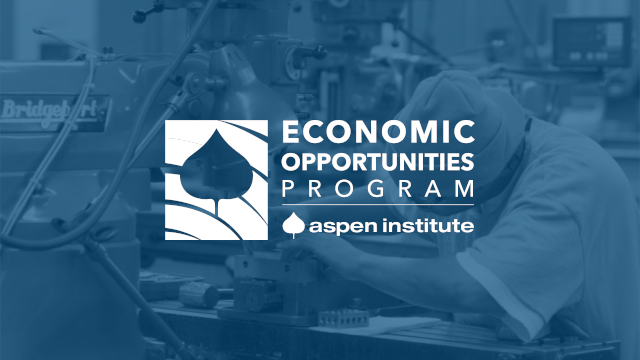WSI Publications by Year
2021
To Build Back Better, Job Quality Is the Key
Race and Gender Wealth Equity and the Role of Employee Share Ownership
Unpacking the Work of Work-Based Learning
2020
The Practice of Improving Job Quality: Views from the Field
Seven Workforce Questions that Are Top of Mind During COVID-19: A Resource for Small Businesses
Voices from the Field: Engaging Employers to Connect Young Adults to Good Fit Employment
2019
Q&A: New Approaches to Engaging Retailers
A Toolkit to Engage Employers and Opportunity Youth on the Future of Work
Harnessing Digital Technology for Frontline Worker Mobility: Eat’n Park’s Partnered Approach
Question Bank for Workforce Service Providers: A Tool for Working with Retailers
Cost of Turnover Tool: Make the business case to improve retention through upskilling and stability
A Retailer Bets on Learning and Development: Goodwill Industries of San Diego County
2018
Chicago’s Fresh Approach to Incumbent Worker Training
BEST Corp: Quality Training for Quality Jobs
Competing on Service: The Case for Good Jobs at the Omni Hotel
“Now Jobs” in Young Adult Workforce Programming
2017
Investing in Workforce Program Innovation
2016
A New WIOA Measure Deserves A New Way Of Measuring
Arizona: Understanding Skill Needs of Technology Occupations
Buffalo, New York: Building Off A Breakthrough
Communities that Work Partnership Playbook
Connecting Young Adults To Employment: Results From A National Survey Of Service Providers
Houston, Texas: Developing Prototypes for Workforce Development Strategies
Implementation Of Accelerating Opportunity
Improving Immigrant Access To Workforce Services: Partnerships, Practices & Policies
New York City: Partnering to Improve Domestic Workers’ Job Quality
Northwest Georgia: Partnering to Connect Workers to Jobs in the Floor Covering Industry
Optimizing Talent: The Promise and the Perils of Adapting Sectoral Strategies for Young Workers
Philanthropy and the Future of Work: Dimensions of Change and Opportunities for Action
Prince George’s County, Maryland: Investing in Infrastructure, Local Businesses, and Jobs
Promising Practices – Northern Virginia Community College
Raise the Floor and Build Ladders: Workforce Strategies Supporting Mobility and Stability
Restore the Promise of Work: Reducing Inequality by Raising the Floor and Building Ladders
The Freelance Economy and Workforce System Meet in the Bay Area
2015
Improving Jobs to Improve Care
Next Generation Employer-Engagement Strategies
The Future of Work for Low-Income Workers and Families
The Second Year of Accelerating Opportunity
Transforming U.S. Workforce Development Policies for the 21st Century
Working Together and Making a Difference
2014
Annotated Bibliography of Resources for Navigators
Connecting People to Work: Workforce Intermediaries and Sector Strategies
Fact Sheet on Paid Sick and Family Medical Leave in the United States
The First Year of Accelerating Opportunity
2013
Apprenticeship: Completion and Cancellation in the Building Trades
Fact sheet on the Foreign-Born Workforce
Fact Sheet on the Federal Minimum Wage
Fact Sheet on Worker Cooperatives, ESOPs, and B Corporations
Helping Adult Learners Navigate Community College and the Labor Market
Profiles of the Direct-Care Workforce and PHI
Profiles of the Residential Construction Workforce and the Workers Defense Project
Profiles of the Restaurant Workforce and Restaurant Opportunities Center-United
Profiles of the Retail Workforce and the Retail Action Project
2012
A Solid Foundation: Key Capacities of Construction Pre-Apprenticeship Programs
Automobile Career Pathways Project (Seattle, Wash.)
Capital IDEA – Electric Utility Sector Work (Austin, Tex.)
Capital IDEA – Health Care Occupations (Austin, Tex.)
Capital IDEA – Program Overview (Austin, Tex.)
Capital IDEA – Teacher Pipeline Project (Austin, Tex.)
Capital IDEA/ACC Partnership (Austin and Round Rock, Tex.)
Carreras en Salud (Careers in Health) (Chicago, Ill.)
Central Arizona Shelter Services – Temporary Employment Services (Phoenix, Ariz.)
Central Piedmont Community College – Pathways to Employment and ESL Pathways (Charlotte, N.C.)
Courses to Employment: Partnering to Create Paths to Education and Careers
Flint Healthcare Career Pathways Project (Flint, Mich.)
Instituto del Progreso Latino – ManufacturingWorks (Chicago, Ill.)
Logistics/Transportation Academy (Los Angeles, Calif.)
NOVA-NVFS Training Futures “Steps to Success” Model (Fairfax County, Va.)
Our Direct-Care Workers: An Overview of the Caregivers in our Workforce
Overview of Workers in Residential Construction
Shoreline Community College – Auto Sales and Service Training Pathways Program (Shoreline, Wash.)
The Restaurant Workforce in the United States
The Retail Trade Workforce in the United States
Training Futures: A case study of a nonprofit-community college partnership
Valley Initiative for Development and Advancement (Rio Grande Valley, Tex.)
Workforce Development, Inc. (Southeastern Minnesota)
2011
Where Labor Supply Meets Labor Demand
2010
Apprenticeship Skills Achievement Program (ASAP) (Cleveland, Ohio)
Building Futures (Providence, R.I.)
Building New Careers: Construction Trades Training Program (Des Moines, Iowa)
Business Value Assessment of Work-Based Learning
CityBuild (San Francisco, Calif.)
Construction Pre-Apprenticeship Programs: Interviews with Field Leaders
Edward J. Malloy Initiative for Construction Skills (New York, N.Y.)
Hartford Jobs Funnel (Hartford, Conn.)
KentuckianaWorks (Louisville, Ky.)
New York City District Council of Carpenters: Building Works (New York, N.Y.)
Newark/Essex Construction Careers Consortium PreApprenticeship Training Program (Newark, N.J.)
Pathways to Success: Oregon Tradeswomen, Inc. (Portland, Ore.)
Project CRAFT-Avon Park (Avon Park, Fla.)
St. Paul Building Trades Council (St. Paul, Minn.)
Tuning In To Local Labor Markets
2009
Construction Pre-Apprenticeship Programs: Results from a National Survey
Job Training That Works: Findings from the Sectoral Employment Impact Study
2008
Systems Change: A Survey of Program Activities
2007
Sectoral Strategies for Low-Income Workers: Lessons from the Field
Update Issue 4: Sector Initiatives and Community Colleges
2006
Skills to Live By: Participant Reflections on the Value of their Sectoral Training Experience
2005
Business Value Assessment Toolkit
Sectoral Workforce Development: Research Review and Future Directions
Update Issue 3: How Does Business Benefit from Sectoral Workforce Development Services?
2004
Building Communications Capacity: Sector Programs Share Their Experiences
Building Effective Employer Relations
Evaluation of the Sectoral Employment Demonstration Program
2003
Key Research Findings And Implications For The Workforce Investment Act
2002
Cooperative Home Care Associates: A Case Study of a Sectoral Employment Development Approach
Grow Faster Together. Or Grow Slowly Apart.
Implications for Welfare Reauthorization and Key Survey Findings
Mid-Project Review: The Department of Labor Sectoral Employment Development Demonstration
Sector Policy Project Executive Summary No. 3
Sector Policy Project Report No. 3
Working with Value: Industry-specific Approaches to Workforce Development
2001
Project QUEST: A Case Study of a Sectoral Employment Development Approach
Sector Policy Project Executive Summary No. 2
Sector Policy Project Report No. 2
2000
Asian Neighborhood Design: A Case Study of a Sectoral Employment Development Approach
Focus: HOPE: A Case Study of a Sectoral Employment Development Approach
Jane Addams Resource Corp: A Case Study of a Sectoral Employment Development Approach
Sector Policy Project Executive Summary No. 1
Sector Policy Project Report No. 1
SEDLP Research Brief No. 1: Key Findings from the Baseline Survey of Participants
SEDLP Research Report No. 1: Methodology and Findings from the Baseline Survey of Participants
1999
Garment Industry Development Corporation: A Case Study of a Sectoral Employment Development Approach
1995
Jobs and the Urban Poor: Privately Initiated Sectoral Strategies
1994
From the Bottom Up: A Collection of Program Profiles
From the Bottom Up: Toward a Strategy for Income and Employment Generation Among the Disadvantaged



